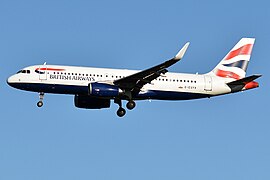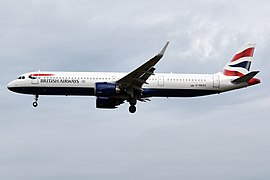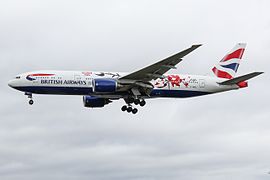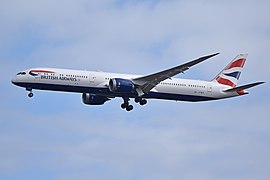Loading AI tools
British Airways operates a fleet of Airbus and Boeing aircraft. It operates a single-aisle fleet of Airbus aircraft, including the Airbus A320-200 and the Airbus A320neo. It also operates a twin-aisle aircraft fleet of the Airbus A350-1000, Airbus A380, Boeing 777 and 787.
Passenger fleet
As of October 2024[update], British Airways operates the following mainline aircraft:[1][2]
| Aircraft | In service | Orders | Passengers[3] | Notes | ||||
|---|---|---|---|---|---|---|---|---|
| F | J | W | Y | Total | ||||
| Airbus A319-100 | 29 | — | — | — | 40 | 83 | 123 | One aircraft, G-EUPJ, is painted in a retro BEA livery. This was to celebrate the centenary of British Airways and still remains painted to this day. |
| Airbus A320-200 | 53 | — | — | — | 48 | 108 | 156 | 4 aircraft to be wet-leased from Finnair from March 2023 until March 2024.[Out of date at July 2024][4] 3 aircraft (G-EUYP/R/S) painted in Oneworld livery.[5] |
| Airbus A320neo | 26 | 7[6] | — | — | 48 | 108 | 156 | IAG ordered further 27 A320neos which have not yet been allocated to a specific airline within the IAG group.[7] |
| Airbus A321neo | 15 | 5[6] | — | — | 56 | 136 | 192 | IAG ordered for a further 23 A321neos which have not yet been allocated to a specific airline within the IAG group.[7] |
| Airbus A350-1000 | 18 | — | — | 56 | 56 | 219 | 331 | Delivered with Club Suites. Largest European operator of its type.[6] |
| Airbus A380-800 | 12 | — | 14 | 97 | 55 | 303 | 469 | |
| Boeing 777-200ER | 43 | — | 8 | 49 | 40 | 138 | 235 | Heathrow configuration with new interior configuration with Club Suites.[8] G-YMML painted in GREAT Festival of Creativity livery. 3 aircraft (G-YMMR/T/U) painted in Oneworld livery.[citation needed] |
| — | 48 | 184 | 272 | |||||
| 14 | 134 | 236 | Gatwick configuration with older Club World seats.[citation needed] | |||||
| — | 32 | 52 | 252 | 336 | ||||
| 48 | 332 | |||||||
| Boeing 777-300ER | 16 | — | 8 | 76 | 40 | 132 | 256 | All with Club Suites (12 retrofitted, 4 factory-fresh). |
| Boeing 777-9 | — | 18[9] | 8 | 65 | 46 | 206 | 325 | Order with 24 options.[9] |
| Boeing 787-8 | 12 | — | — | 31 | 37 | 136 | 204 | Retrofitted Club Suites. |
| 35 | 25 | 154 | 214 | Older Club World seats. | ||||
| Boeing 787-9 | 18 | — | 8 | 42 | 39 | 127 | 216 | Older Club World seats. |
| Boeing 787-10 | 11 | 7[10] | 8 | 48 | 35 | 165 | 256 | Delivered with Club Suites. Order with 6 options on the order book. |
| Total | 253 | 37 | ||||||
Cargo fleet
IAG's cargo division, IAG Cargo, handles cargo operations using capacity on British Airways' passenger aircraft. IAG reached an agreement with Qatar Airways in 2014 to operate flights for IAG Cargo using Boeing 777F aircraft owned by Qatar Airways Cargo.[11][needs update]
British Airways World Cargo was the airline's freight division before its merger with Iberia Cargo to form IAG Cargo. Aircraft types used by the division between 1974 and 1983 were Vickers 953C,[12] Boeing 707-300C[13] and Boeing 747-200F.[14] The Boeing 747-400F was operated from the 1990s to 2001 through Atlas Air and 2002 to early 2012 by Global Supply Systems; of these only one of Atlas Air's aircraft wore BA livery,[15] the others flew in Atlas and Global Supply's own colours. From 2012 until Global Supply System's contract terminated in 2014, three Boeing 747-8F aircraft were flown for British Airways World Cargo.[16]
Gallery
- Airbus A319-100 in BEA retro livery
- Airbus A320neo in BA Better World livery
- Boeing 777-200ER in GREAT Festival of Creativity Livery
Except for the Boeing 707 and early Boeing 747 variants from BOAC, British Airways inherited a mainly UK-built fleet of aircraft when it was formed in 1974. The airline introduced the Boeing 737 and Boeing 757 into the fleet in the 1980s, followed by the Boeing 747-400, Boeing 767 and Boeing 777 in the 1990s. BA was the largest Boeing 747-400s operator, with 57 in its fleet.[17][18] Before the introduction of the 787, when Boeing built an aircraft for British Airways, it was allocated the customer code 36, which appeared in their aircraft designation as a suffix, such as 777-236.[19]
In 1991, British Airways placed its first order for 777-200 aircraft, ordering another four for fleet expansion in 2007 at a cost of around US$800 million.[20] BA's first 777s were fitted with General Electric GE90 engines. Still, BA switched to Rolls-Royce Trent 800s for subsequent aircraft.[21][22]
Later in 2007, BA announced their order of thirty-six new long-haul aircraft, including twelve Airbus A380s and twenty-four Boeing 787 Dreamliners.[23] Rolls-Royce Trent engines were again selected for both orders with Trent 900s powering the A380s and Trent 1000s powering the 787s. The Boeing 787s were scheduled to replace 14 of British Airways' Boeing 767 fleet, while the Airbus A380s were supposed to replace 20 of BA's Boeing 747-400s until their early retirement in the wake of the COVID-19 pandemic.[citation needed]
On 1 August 2008, BA announced orders for six Boeing 777-300ERs and options for four more as an interim measure to cover for delays over the deliveries of their 787s. Of the six that have been ordered, four will be leased and British Airways will fully acquire two.[24]
On 22 April 2013, IAG confirmed that it had signed a memorandum of understanding to order 18 A350-1000 XWB aircraft for British Airways, with an option for a further 18. The aircraft would replace some of the airline's fleet of Boeing 747-400s.[25] Options for 18 Boeing 787 aircraft, part of the original contract signed in 2007, have been converted into firm orders for delivery between 2017 and 2021.[26]
On 26 June 2013, British Airways took delivery of its first Boeing 787 Dreamliner. The aircraft began operations in Toronto on 1 September 2013 and began service to Newark on 1 October 2013.[27] BA's first A380 was delivered on 4 July 2013.[28] It began regular services to Los Angeles on 24 September 2013, followed by Hong Kong on 22 October 2013.[29]
On February 28, 2019, British Airways parent International Airlines Group ordered up to 42 777-9, 18 firm and 24 options, valued at up to $18.6 billion (~$21.9 billion in 2023), to replace its 747-400s.[30]
At the 2019 Paris Air Show, British Airways owner IAG signed a letter of intent to purchase 200 Boeing 737 MAX aircraft, despite the type still being grounded worldwide.[31][32]
In July 2019, the British carrier took delivery of its first Airbus A350-1000 XWB aircraft, fitted without First, but with more of the new Club World suites.[33]
On 16 July 2020, British Airways announced it was immediately retiring the remaining Airbus A318-100 and Boeing 747-400 aircraft, the last of the latter having flown the previous month. British Airways had originally intended to phase out the last 747s by 2024 but brought the plans forward in part due to the downturn in air travel following COVID-19 pandemic and to focus on replacing the 747 with the more fuel-efficient Airbus A350, Airbus A380 and Boeing 787.[34][35]
This section needs additional citations for verification. (February 2017) |
| Aircraft | Total[36] | Introduced | Retired | Notes | Refs |
|---|---|---|---|---|---|
| Airbus A318-100 | 2 | 2009 | 2020 | Operated BA1/BA2 and formerly also BA3/BA4 between London–City and New York–JFK | [citation needed] |
| Airbus A320-100 | 5 | 1988 | 2007 | [37] | |
| Airbus A321-200 | 13 | 2001 | 2024 | ||
| 11 | Transferred to BA EuroFlyer | ||||
| BAC One-Eleven 400 | 7 | 1974 | 1988 | [lower-alpha 1] | |
| BAC One-Eleven 500 | 33 | 1974 | 1993 | [lower-alpha 2] | |
| 1 | G-AVMO is preserved at Scottish National Museum of Flight | ||||
| 1 | G-AVMU is preserved at Imperial War Museum Duxford | ||||
| BAe 146-200 | 3 | 1989 | 1990 | ||
| BAe 146-300 | 1 | 1992 | 1994 | ||
| BAe ATP | 15 | 1989 | 1994 | ||
| Boeing 707-300 | 12 | 1974 | 1984 | [lower-alpha 3][lower-alpha 4] | |
| Boeing 707-400 | 9 | 1974 | 1981 | [lower-alpha 4] | |
| 1 | Nose and forward fuselage of G-APFJ on display at Scottish National Museum of Flight | ||||
| Boeing 737-200 | 50 | 1977 | 2001 | ||
| Boeing 737-300 | 22 | 1988 | 2009 | ||
| Boeing 737-400 | 39 | 1991 | 2015 | ||
| Boeing 737-500 | 12 | 1996 | 2009 | ||
| Boeing 747-100 | 17 | 1974 | 1999 | [lower-alpha 4][38] | |
| 1 | Nose of G-AWNG display at Hiller Aviation Museum, California (not in BA colours) | ||||
| 1 | 1990 | Written off as flight BA149 | |||
| Boeing 747-200 | 27 | 1977 | 2002 | First 747-200 to be powered with Rolls-Royce RB211-524B engines | [38] |
| 1 | G-BDXJ preserved at Dunsfold Aerodrome (not in BA colours) | ||||
| Boeing 747-400 | 57 | 1989 | 2020 | First 747-400 to be powered with Rolls-Royce RB211-524G engines Replaced by Airbus A350-1000, Airbus A380, Boeing 777-300ER, Boeing 787 Dreamliner |
[38] |
| 1 | G-CIVW, wearing the standard Chatham Dockyard livery is preserved at Dunsfold Aerodrome | ||||
| 1 | G-BNLY, wearing the Landor livery is preserved at Dunsfold Aerodrome | ||||
| 1 | G-CIVB wearing the Negus livery is preserved at Cotswold Airport | ||||
| 1 | G-BYGC, wearing the BOAC livery-planned to be preserved at MOD St Athan, however was scrapped in October 2023 | ||||
| Boeing 757-200 | 61 | 1983 | 2010 | Launch customer together with Eastern Air Lines Replaced by Airbus A321 |
[39][40] |
| Boeing 767-300ER | 29 | 1990 | 2018 | Launch customers with Rolls-Royce RB211 engine Replaced by Airbus A321neo, Boeing 777-200ER and Boeing 787 7 aircraft sold to Qantas Australia 4 aircraft currently operated by Eastern Airlines, LLC |
[41] |
| Boeing 777-200 | 5 | 1995 | 2020 | Launch customer with General Electric GE90 engine Three of the aircraft (G-ZZZA, G-ZZZB and G-ZZZC) were among the first 777s ever built They were used for the GE90 certification campaign before being delivered to BA in November 1995 Replaced by Boeing 777-300ER and 777-200ER |
[42][43] |
| Aérospatiale-BAC Concorde | 8[lower-alpha 5] | 1976 | 2003 | All aircraft preserved, see Concorde aircraft histories | [44] |
| Hawker Siddeley Trident 1C/E | 24 | 1974 | 1983 | [lower-alpha 2] | |
| 1 | G-ARPO, wearing Northeast Airlines livery is preserved at North East Aircraft Museum | ||||
| Hawker Siddeley Trident 2E | 15 | 1974 | 1985 | [lower-alpha 2] | |
| 1 | G-AVFB, wearing BEA livery is preserved at Imperial War Museum Duxford | ||||
| Hawker Siddeley Trident 3B | 23 | 1974 | 1985 | [lower-alpha 2] | |
| 1 | G-AWZK, wearing BEA livery is displayed at Manchester Airport | ||||
| 1 | G-AWZM, is preserved at Science Museum | ||||
| 1 | Nose of G-AWZP also preserved at Science and Industry Museum, Manchester | ||||
| Hawker Siddeley HS 748 | 13 | 1975 | 1988 | ||
| Lockheed L-1011-1 TriStar | 10 | 1975 | 1983 | ||
| Lockheed L-1011-200 TriStar | 8 | 1980 | 1991 | ||
| Lockheed L-1011-500 TriStar | 8 | 1979 | 1983 | ||
| McDonnell Douglas DC-10 | 8 | 1988 | 1999 | ||
| Vickers VC10 | 9 | 1974 | 1976 | [lower-alpha 4] | |
| Vickers Super-VC10 | 15 | 1974 | 1981 | [lower-alpha 4] | |
| Vickers Vanguard | 12 | 1974 | 1979 | [lower-alpha 2] | |
| 1 | G-APEP is preserved at Brooklands Museum (not in BA colours) | ||||
| Vickers Viscount-700 | 2 | 1974 | 1976 | [lower-alpha 2] | |
| Vickers Viscount-800 | 35 | 1974 | 1982 | [lower-alpha 2] |
Notes
- Only 7 in service, G-BBDG was never flown by BA but used for spare parts and static testing
Gallery
A Vickers Super VC10 in 1975.
A Boeing 747-200 in 1989.
Concorde in 1986.
A Boeing 757-200 in 2003, wearing one of the British Airways ethnic liveries.
An Airbus A318-100 formerly operated on a sole long-haul route between London-City and New York-JFK.
Wikiwand in your browser!
Seamless Wikipedia browsing. On steroids.
Every time you click a link to Wikipedia, Wiktionary or Wikiquote in your browser's search results, it will show the modern Wikiwand interface.
Wikiwand extension is a five stars, simple, with minimum permission required to keep your browsing private, safe and transparent.















